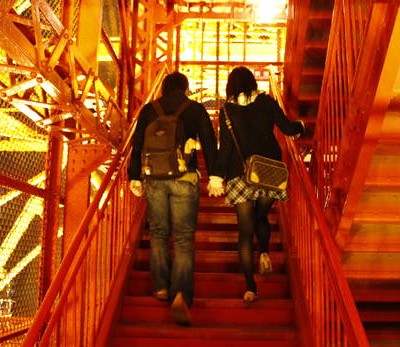20 Weird Facts About Valentine’s Day in Japan
You probably thought you have seen everything Japan has to offer, from the world’s most delectable cuisine (and sometimes life-threatening), the weirdest capsule hotels, and to the most uptight of traditions in historic Shinto shrines. If you think maid cafes and love hotels are bordering on crazy, fetish entertainment, watch how Japan changes the very definition of Valentine’s Day.
Although Japan is slowly adapting to modern celebrations for western holidays, the Land of the Rising Sun still manages to fall into observing meaningful yet the weirdest traditions ever. Getting caught in Tokyo’s spell is the coolest thing at the moment, but can you follow through these 20 weird facts about Valentine’s Day in Japan?
1. While it is also celebrated on the 14th of February, Valentine’s Day in Japan is hardly a romantic day for many lovers. Women are obligated to give chocolates to men. Because of this, Valentine’s Day in Japan is also known as Happy Chocolate Obligation Day!
2. The tradition was said to originate from an incorrect translation of the word “man” and translated as “woman” by a chocolate company ad executive. “Women should give men chocolate on Valentine’s Day.”
3. Another version of the story claimed that the ad executive’s wife was a nagger and through his marketing reach, he was able to spread the word of this supposed Valentine’s Day obligation.
4. It is customary for women in the workplace to give their male coworkers with chocolates. However, if Valentine’s Day falls on a holiday or Sunday, women can exercise a bit of girl power: giri-choko is given to male coworkers whom they are not so fond of. The male coworker can also receive cho-giri choko or chocolate that is even cheaper than the “obligatory chocolate”.
5. On the other hand, a woman’s apple-of-the-eye gets an extra special box or Honmei-choko that is personally made by the woman.
6. Oddly enough, while the tradition is often celebrated in the workplace, only 27% of women in a survey conducted last 2000 gave chocolates to their coworkers, and majority gave to their husbands or boyfriends, in a country where birth rate is at an all-time low.
7. Women may also exchange chocolates gifts or Tomo-choko to their female friends.
8. With this, February 14 is the best time of the year to buy chocolates from depachikas all over Japan as everything goes virtually on sale.

9. While it is also celebrated in South Korea, Taiwan and China, men in Japan observe the 14th of March as the White Day, where men are expected to reciprocate for all the obligatory chocolates they received on February 14.
10. Rumors say the ad executive wasn’t remorseful with his mistake but created an effective way of boosting chocolate sales.
11. March 14 is known as “White Day” or Howaito De, because of the white gifts that men give to the women in their lives. Men give all sorts of white-colored gifts to women, such as white marshmallow, white chiffon cakes, white chocolates and even white lingerie. If the man wants to return his love to the woman, his gift should exceed the giri-choko. Else, it’s love unrequited with cheaper gifts.
12. Because of all these rules, Christmas in Japan looks a bit more like Valentine’s Day like how it’s being celebrated in other parts of the globe. Many lovers in Japan look into Christmas Day for dinner dates and romantic night strolls, so it is very difficult to book tables in restaurants during this time of the year!
13. But romance is not all lost in the city of Tokyo, as lovers can catch a bird’s eye view of Tokyo at Tokyo Tower on February 14, the only time people can go up the observatory deck.
14. Just like how stringent the traditions are with Happy Chocolate Obligation Day, so are the legendary tales! Stories say that couples who witness the switching off of lights at Tokyo Tower at midnight will stay together forever.
15. To appease angry couples, the Tokyo Tower indeed shuts down their lights at exactly 12:00 midnight operationally, to make their wishes come true.
16. Valentine’s Day in Tokyo seems a bit more like Paris, where lovers also visit the island of Enoshima, one of the beaches closest to Tokyo and Yokohama. Here, couples lock “love locks” by the Koibito no Oka or “Lover’s Hill”, symbolizing their unwavering love throughout the years.
17. Just 60 minutes away from Tokyo via Hikari Shinkansen is the so-called Riviera of Japan and home to Mount Fuji, the Shizuoka prefecture. This is one of the more popular dating spots during February 14 where lovers ring Ai No Kane or the “Bell of Love” to feel their love vibrate across the land.
18. It won’t be Valentine’s Day in Tokyo without superstitions. Lovers in Tokyo skip visiting Tokyo Disneyland and Disneysea on February 14. It must be a jinx but couples that do often end in breakup.
19. All the more reason to skip the Inokashira Park in Tokyo, as couples who ride the swan boat also end up brokenhearted. In fact, couples in Tokyo are so superstitious, they stay away from lakes and boats during this day as this leads to a nasty lover’s quarrel.
20. Nothing tops weirdness than the news of protests of lonely Japanese men in the Shibuya ward from last year’s Valentine’s Day. As the obligatory chocolates are still being observed until today, the Kakuhido group, which has been around since 2006, blames chocolate capitalists for this “blood-soaked conspiracy of Valentine’s Day”. Kakuhido’s founder Katsuhiro Furusawa was said to have been dumped and deemed unpopular to women.
Strangely enough, Kakuhido calls public display of affection or flirting “terrorism”.

Talk about a bloody Valentine. Could Valentine’s Day get any weirder in Tokyo?
Featured image courtesy of japan-guide.com.



